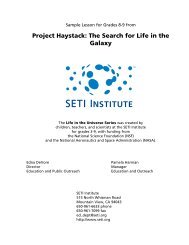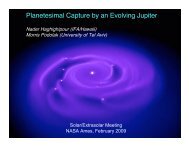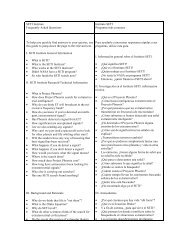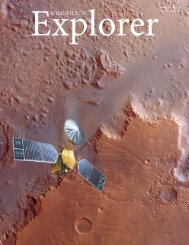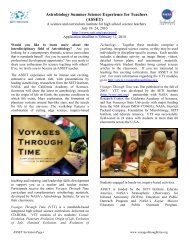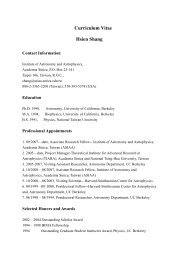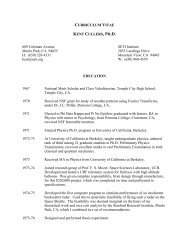Inside the Boardroom with Alan Bagley - SETI Institute
Inside the Boardroom with Alan Bagley - SETI Institute
Inside the Boardroom with Alan Bagley - SETI Institute
Create successful ePaper yourself
Turn your PDF publications into a flip-book with our unique Google optimized e-Paper software.
http://www.oldstarlight.com<br />
The Moon absorbs any transfer of orbital to rotational angular moment, preventing<br />
<strong>the</strong> Earth from flipping.<br />
Moon Stabilizes Earth’s<br />
Rotation<br />
The most popular <strong>the</strong>ory for <strong>the</strong> origin<br />
of <strong>the</strong> moon is that it came from <strong>the</strong><br />
Earth. We can calculate evolutionary histories<br />
of <strong>the</strong> moon’s orbit as it moved away<br />
from <strong>the</strong> Earth after formation. (It is still<br />
moving away due to <strong>the</strong> Earth’s tidal pull<br />
at about one inch per year. The majority of<br />
<strong>the</strong> tidal dragging comes from Earth’s rotational<br />
slowdown, <strong>with</strong> most being caused<br />
by waters dragging over <strong>the</strong> fairly shallow<br />
Bering Sea.) In doing some of <strong>the</strong>se kinds<br />
of calculations for Mars, it was discovered<br />
that <strong>the</strong> direction of Mars’ rotational axis<br />
could flip ra<strong>the</strong>r suddenly. Now this is not<br />
<strong>the</strong> normal “precession” (as it is called) of a<br />
few degrees that changes, for example, our<br />
north star though <strong>the</strong> millennia. Mars was<br />
calculated to have flipped its rotation axis<br />
up to 90 degrees in as little as a couple of<br />
million years. This was a result of <strong>the</strong> orbital<br />
angular momentum, under certain<br />
circumstances, being transferred to <strong>the</strong><br />
rotational angular momentum and causing<br />
a coupling that led to such a flip in rotation<br />
axis direction.<br />
So why has this not occurred on Earth,<br />
whose axis has seemingly not flipped by<br />
more than a few degrees The apparent<br />
explanation is that <strong>the</strong> Moon absorbs any<br />
transfer of orbital to rotational angular<br />
moment, preventing <strong>the</strong> flip.<br />
Would such a flip be important It could<br />
get very serious – like <strong>the</strong> time a couple<br />
of hundred million years ago when all <strong>the</strong><br />
continents were combined into one big<br />
continent called “Pangaea”—if <strong>the</strong> Earth’s<br />
rotation axis flipped such that this one big<br />
continent became a polar continent like<br />
Antarctica. So, it would appear that a moon<br />
is required for a stable planet <strong>with</strong> life.<br />
This was perhaps surprising news to<br />
folks that would like to see habitable planets<br />
widespread in <strong>the</strong> galaxy requiring, as it<br />
does, both an earthlike planet in <strong>the</strong> circumstellar<br />
habitable zone as well as a fairly large<br />
satellite. This would seem to rule out habitable<br />
planets being very common. However,<br />
additional research into <strong>the</strong> rotational histories<br />
of <strong>the</strong> planets shows that <strong>the</strong> Earth<br />
used to spin a lot faster. If <strong>the</strong> earth spins<br />
faster, that also acts as a protection against<br />
flipping of <strong>the</strong> rotation axis. So, perhaps if<br />
<strong>the</strong> moon had not come off <strong>the</strong> Earth, our<br />
world would still be spinning fast enough<br />
to stabilize itself against flipping. Thus<br />
<strong>the</strong>re may be many o<strong>the</strong>r habitable planets<br />
<strong>with</strong>out a large moon, but <strong>the</strong> inhabitants<br />
will have even fewer hours in <strong>the</strong>ir day than<br />
we do.<br />
The moon, of course, is now perfectly<br />
placed to exactly cover <strong>the</strong> solar disk during<br />
eclipses. This perfect fit has allowed,<br />
for example, a test of General Relativity,<br />
<strong>the</strong> uncovering of <strong>the</strong> element helium,<br />
and <strong>the</strong> discovery of <strong>the</strong> solar corona. And<br />
clearly <strong>the</strong> moon has been a great stimulus<br />
and practice ground for our first efforts at<br />
space travel. However, moving out at an<br />
inch a year, in about 1.6 billion years <strong>the</strong><br />
moon will no longer be able to stabilize<br />
our planet’s spin. We’ll have to be ready for<br />
a climatologically wild ride by <strong>the</strong>n unless<br />
we figure out what to do. Eventually <strong>the</strong><br />
Earth will have <strong>the</strong> same rotation period as<br />
<strong>the</strong> moon’s orbit (i.e., <strong>the</strong> day will equal <strong>the</strong><br />
month) and <strong>the</strong>n <strong>the</strong> moon may be expected<br />
to fall back toward <strong>the</strong> Earth, forming a<br />
ring perhaps not dissimilar to those around<br />
Saturn. It will, no doubt, be a great show.<br />
see ANDROMEDA, pg. 20<br />
SAVE THE DATE<br />
Sunday September 25, 2005!<br />
Join us for<br />
<strong>the</strong> <strong>SETI</strong> <strong>Institute</strong>’s<br />
Annual Team<strong>SETI</strong><br />
Ice Cream Social<br />
To sign up for Team<strong>SETI</strong><br />
visit: www.seti.org/teamseti<br />
Second Quarter 2005 - Celebrating our 20th Anniversary 19




